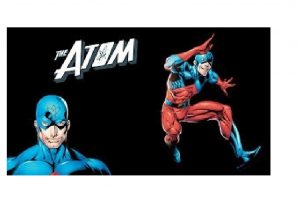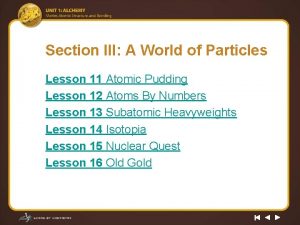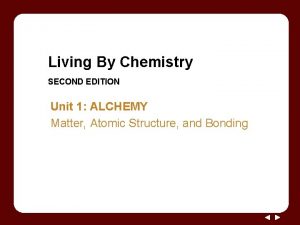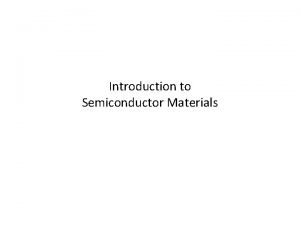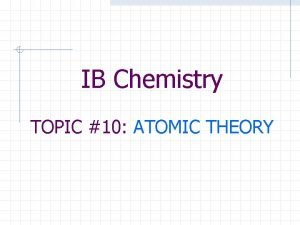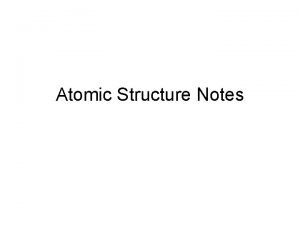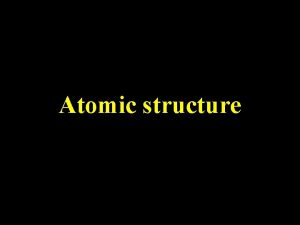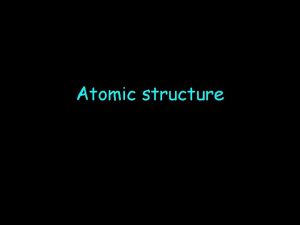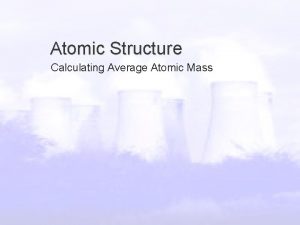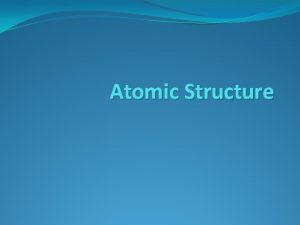Atomic Structure What is an atom Atom the
















- Slides: 16

Atomic Structure

What is an atom? • Atom: the smallest unit of matter that retains the identity of the substance

Atomic Structure • Atoms are composed of 2 regions: Electron Cloud Nucleus

The Nucleus: the center of the atom that contains the mass of the atom • The Nucleus contains Protons and Neutrons. • Protons: positive charge • Neutrons: neutral charge

The Electron Cloud Electron cloud: region that surrounds the nucleus that contains the space/volume in the atom • Contains the Electrons • Electron: negative charge Has relatively no mass

An atom must be balanced! • In an atom: • The # of protons = the # of electrons • The neutrons have no charge; therefore they do not have to equal the number of protons or electrons

How can we find the number of protons, neutrons, and electrons? • Atomic number: this number indicates the number of protons in an atom • Atomic Mass: the number of protons and neutrons in the atom.

Label this on your Periodic Table Atomic Number Atomic Mass 1 H Hydrogen 1. 008 Symbol Element’s Name

Calculating the neutrons How can we find the Neutrons? # of neutrons = mass # - atomic #

What about the electrons? • The electrons are equal to the number of protons • Atomic # = protons = electrons

Determining the number of protons, neutrons and electrons • Li has an atomic number of 3 and a mass number of 7 • Protons = ____ (atomic #) • Neutrons= ____ (mass # - atomic #) • Electrons = ____ (electrons = protons) • Ne has an atomic number of 10 and a mass number of 20 • P = ____ N = ____ E = ____

How exactly are the particles arranged? • Bohr Model of the atom: 3 rd ring holds up to 18 e- 4 th ring holds up to 32 e- Nucleus protons and neutrons 1 st ring holds up to 2 e 2 nd ring holds up to 8 e-

What does Carbon look like? Atomic # = 6 Mass # = 12 6 p and 6 n live in the nucleus p+ = 6 no = 6 e- = 6

Bohr Models • At the bottom of your notes, draw the Bohr Models for: • Lithium (Li) • Magnesium (Mg)

Atomic Structure and Bohr Model Practice On the front… • Boron (B) • Nitrogen (N) • Calcium (Ca) • Nickel (Ni) On the back… • Sodium (Na) • Beryllium (Be) • Neon (Ne) • Sulfur (S)

Bohr Model Trading Cards • Choose 2 elements from the Periodic Table. • Write the info (atomic #, symbol, etc. ) for those elements on the 2 papers provided. • Trade with 2 different people and draw the Bohr Model for that element on the back. • Write your name on the Bohr Model side!
 The structure of the atom section 2 defining the atom
The structure of the atom section 2 defining the atom Is atomic mass and relative atomic mass the same
Is atomic mass and relative atomic mass the same Atomic trends
Atomic trends Ion size trend
Ion size trend O
O Distinguish between mass number and atomic mass.
Distinguish between mass number and atomic mass. Atomic number vs atomic radius
Atomic number vs atomic radius Matterville worksheet
Matterville worksheet Lesson 11 atomic pudding models of the atom
Lesson 11 atomic pudding models of the atom Lesson 11 atomic pudding models of the atom answer key
Lesson 11 atomic pudding models of the atom answer key Teori atom
Teori atom Atomic structure and properties ap chemistry
Atomic structure and properties ap chemistry Calcium subatomic particles
Calcium subatomic particles Atomic universe theory
Atomic universe theory Atomic structure of a conductor
Atomic structure of a conductor First ionization energy of calcium equation
First ionization energy of calcium equation Ib chemistry atomic structure
Ib chemistry atomic structure







